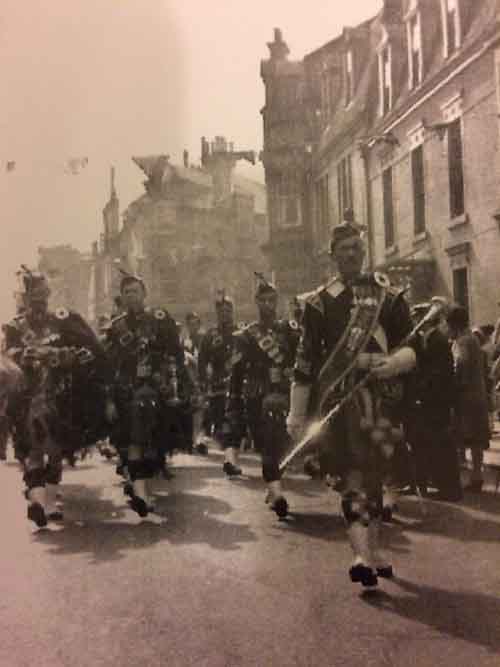A rare image of a rare piping legend
For such a legendary figure in the history of Highland piping, there are amazingly few images known to exist of Pipe-Major John “Jock” McLellan, of Dunoon, Scotland.
But today, pipes|drums adds one more to the handful of photos of the great man.
The picture shows McLellan at the far left, coming down Argyll Street, the main thoroughfare in Dunoon. He is marching with the 8th Argyll & Sutherland Highlanders, with which he served gallantly in both World War I, and with the Highlight Light Infantry in the Boer War, during which he was awarded the Distinguished Conduct Medal for gallantry in battle.
The year is 1929 and the occasion is the Cowal Gathering, the event that was for more than a century the world’s largest Highland games. It was home of the de facto World Pipe Band Championships until 1947, when the Scottish Pipe Band Association formalized the name and event, moving it from site to site until it found a seemingly permanent home in Glasgow in 1982.

The picture is taken by Neil Gallagher when he was about 19. He was a keen photographer at the time, and continued with the art to become a professional photographer.
Neil Gallagher was McLellan’s nephew, and the Henderson side of McLellan’s lineage remains strong in piping today. Jim Henderson, the former pipe-major of the now defunct Grade 1 Babcock-Renfrew Pipe Band and one of the piping world’s most influential teachers, still thriving in Dunoon. McLellan’s great-grand-nephew is Alasdair Henderson, one of the top solo pipers of today, who, along with Stuart Liddell and many other highly successful pipers, was taught by Jim Henderson.
The image was provided to us by Andrew Gallagher, who himself lists John McLellan as his great uncle. Gallagher’s grandmother, Sarah Gallagher (nee McLellan), was McLellan’s sister.
John McLellan was born in 1875 and known to his friends as “Jock.” He is renowned as a composer of some of the most enduring and well-played and loved compositions in the Highland bagpipe repertory, including the now-classic 3/4 marches “Lochanside,” “The Highland Brigade at Magersfontein,” “The Heroes of Vittoria,” “The Bloody Fields of Flanders” and “The Dream Valley of Glendaruel.”
His 2/4 marches number several standards, namely “The Taking of Beaumont Hamel,” “The Cowal Gathering,” “South Hall” and “Glen Caladh Castle.”
In addition to his accomplishments as a piper, the quiet and self-effacing McLellan was a successful painter, fiddler and published poet. By far his most-heard composition overall worldwide is “The Road to the Isles,” to which also eventually wrote the lyrics. Interestingly, the tune had several iterations and names, originally titled “The Bens of Jura,” then “The 71st’s Farewell to Dover,” then “The Highland Brigade’s March to Heilbron,” and later “The Burning Sands of Egypt” before it settled into the familiar form of today’s “Road to the Isles.”
He served in the Great War with the equally great Willie Lawrie. When Lawrie was invalided, he was succeeded as pipe-major of the 8th Argylls by James Wilson, who held the role until 1919 when McLellan received the appointment, which McLellan held until he retired in 1930.
Jock McLellan never married and had no children. He died at age 73 on July 31, 1949, and was buried with full military honours in Dunoon Cemetery, near Loch Loskin, the small “lochan” that inspired him to compose “Lochanside.”
Our thanks to Andrew Gallagher for sharing this historically significant photograph of the historically important piper, Pipe-Major John “Jock” McLellan, Dunoon, DCM.

When home quite a few years ago now, I went up to the local Dunoon Argyll band practice, just to have a listen. Jim Henderson was there to help the band. At the break he remembered me and my family so while chatting to him I could see he had a bad cold. It was a cold wet miserable night and the hall was freezing but there he was, playing away helping the band. Sitting there it occurred to me how much he and all the Hendersons had done for local piping.
The next day I had two hours to kill at Glasgow airport so while waiting for my flight, I scribbled down this wee ditty on a serviette, a toast to the many Henderson pipers of Dunoon.
“Here’s Tae The Henderson’s”
Here’s tae aw thon Henderson’s, guid pipers sure, wan an’ aw;
Fur liftin’ aw oor heilan hearts, when ‘er we heard them blaw;
An’ aw the quiet men, playin’ away that geid their precious time;
Unsung heroes then, n’er tae get a mention bu’ I remember fine;
See them comin’, sae proudly marchin’ up Argyll an’ thru’ the toon;
The auld 8th Battalion Pipe an’ Drum, wi’ a richt guid McLellan tune;
Yer pipes aye call me back hame tae Cowal, an’ bonnie wee Dunoon.
Slainte
Hamish Yuile
Glasgow Airport ’03